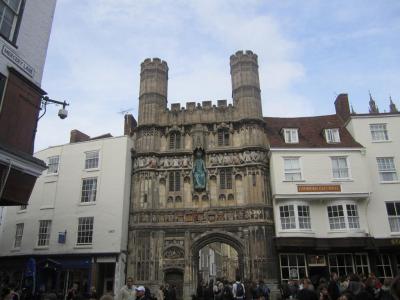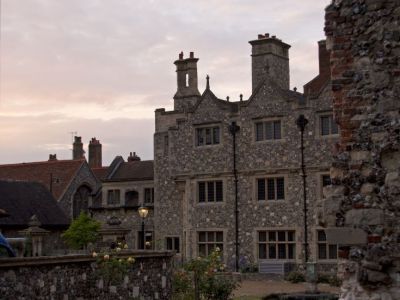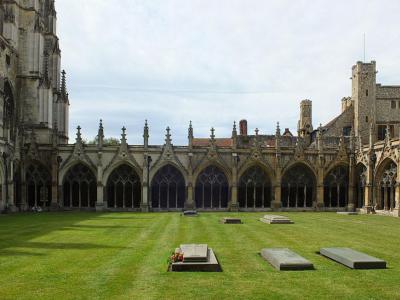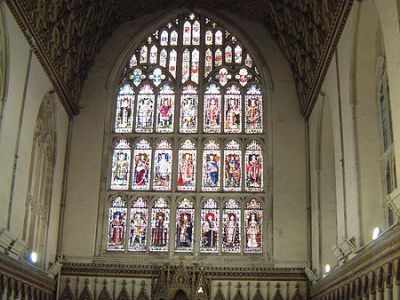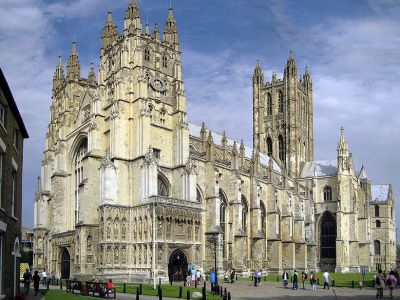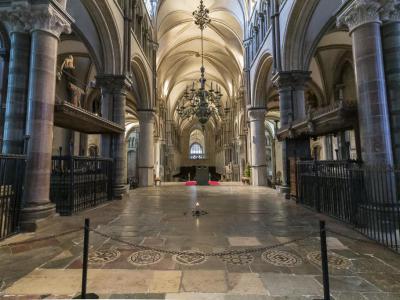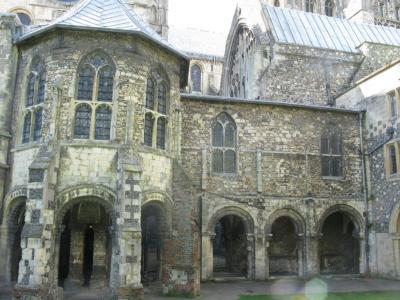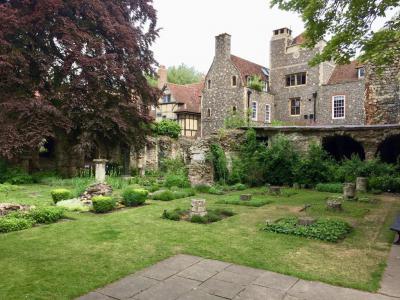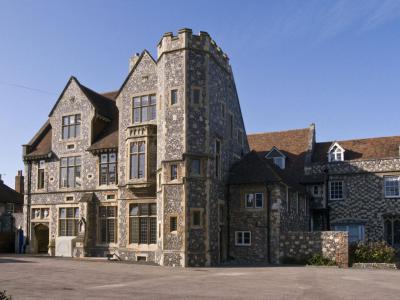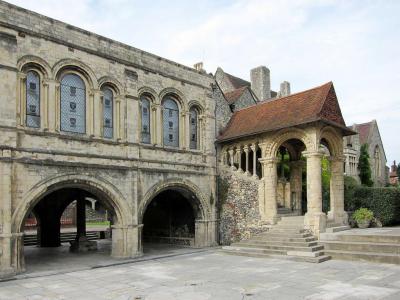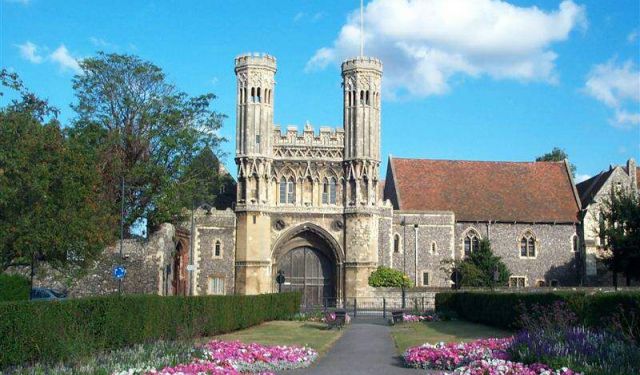Canterbury Cathedral and Grounds (Self Guided), Canterbury
Canterbury Cathedral, one of the oldest churches that played a crucial role in English Christianity, stands within its own walled area, surrounded by Medieval buildings and ruins.
At the heart of this ensemble rises the cathedral itself, a magnificent example of medieval architecture and a UNESCO World Heritage Site. As you enter, you'll pass through the imposing Christ Church Gate, a grand entrance that sets the tone for the experience ahead.
Adjacent to the cathedral stands the Old Palace, a building steeped in centuries of ecclesiastical significance. The Cloisters, located on the north side of the cathedral, with their covered colonnade adorned with a grandiose domed roof, is a space for contemplation, reading, and writing, with ceiling knobs displaying the arms of those who contributed to the cathedral's construction and decoration.
Nearby, the Chapter House is a marvel of Gothic design, featuring magnificent medieval stained glass, a lofty timber roof, and stone seats, serving as a historic meeting place for monks and priests and later as a venue for sermons.
As you explore the grounds, you'll encounter landmarks such as the Water Tower, a testament to the cathedral's practical infrastructure, and the Healing Garden, a newly planted oasis, featuring ancient medicinal herbs cultivated for centuries and still utilized by modern herbalists.
Next to the garden is the prestigious King's School which has played a pivotal role in the educational landscape of Canterbury for centuries. The oldest structure in the Canterbury Cathedral precinct, the Norman Staircase, now stands as part of King's School, adjacent to the Memorial Court erected after World War I, serving as a memorial for those lost in both world wars.
Whether you're drawn to Canterbury Cathedral for its historical significance, architectural beauty, or spiritual resonance, a visit to this iconic site promises to be a memorable experience. So, take the opportunity to immerse yourself in centuries of tradition and heritage, and discover the timeless allure of Canterbury Cathedral and its grounds.
At the heart of this ensemble rises the cathedral itself, a magnificent example of medieval architecture and a UNESCO World Heritage Site. As you enter, you'll pass through the imposing Christ Church Gate, a grand entrance that sets the tone for the experience ahead.
Adjacent to the cathedral stands the Old Palace, a building steeped in centuries of ecclesiastical significance. The Cloisters, located on the north side of the cathedral, with their covered colonnade adorned with a grandiose domed roof, is a space for contemplation, reading, and writing, with ceiling knobs displaying the arms of those who contributed to the cathedral's construction and decoration.
Nearby, the Chapter House is a marvel of Gothic design, featuring magnificent medieval stained glass, a lofty timber roof, and stone seats, serving as a historic meeting place for monks and priests and later as a venue for sermons.
As you explore the grounds, you'll encounter landmarks such as the Water Tower, a testament to the cathedral's practical infrastructure, and the Healing Garden, a newly planted oasis, featuring ancient medicinal herbs cultivated for centuries and still utilized by modern herbalists.
Next to the garden is the prestigious King's School which has played a pivotal role in the educational landscape of Canterbury for centuries. The oldest structure in the Canterbury Cathedral precinct, the Norman Staircase, now stands as part of King's School, adjacent to the Memorial Court erected after World War I, serving as a memorial for those lost in both world wars.
Whether you're drawn to Canterbury Cathedral for its historical significance, architectural beauty, or spiritual resonance, a visit to this iconic site promises to be a memorable experience. So, take the opportunity to immerse yourself in centuries of tradition and heritage, and discover the timeless allure of Canterbury Cathedral and its grounds.
How it works: Download the app "GPSmyCity: Walks in 1K+ Cities" from Apple App Store or Google Play Store to your mobile phone or tablet. The app turns your mobile device into a personal tour guide and its built-in GPS navigation functions guide you from one tour stop to next. The app works offline, so no data plan is needed when traveling abroad.
Canterbury Cathedral and Grounds Map
Guide Name: Canterbury Cathedral and Grounds
Guide Location: England » Canterbury (See other walking tours in Canterbury)
Guide Type: Self-guided Walking Tour (Sightseeing)
# of Attractions: 10
Tour Duration: 1 Hour(s)
Travel Distance: 0.8 Km or 0.5 Miles
Author: Sandra
Sight(s) Featured in This Guide:
Guide Location: England » Canterbury (See other walking tours in Canterbury)
Guide Type: Self-guided Walking Tour (Sightseeing)
# of Attractions: 10
Tour Duration: 1 Hour(s)
Travel Distance: 0.8 Km or 0.5 Miles
Author: Sandra
Sight(s) Featured in This Guide:
- Christ Church Gate
- Old Palace
- The Cloisters
- Chapter House
- Canterbury Cathedral
- Trinity Chapel at Canterbury Cathedral
- The Water Tower
- Healing Garden
- King's School
- Norman Staircase & Memorial court
1) Christ Church Gate
Christ Church Gate stands as the magnificent ceremonial entrance into the precincts of Canterbury Cathedral, welcoming visitors into one of England’s most historically and architecturally rich sites. Crafted around 1520 in the Tudor-Gothic style, this striking gatehouse was carefully cleaned and structurally restored in recent years, bringing to light the intricate stone carvings, heraldic shields, and mythical beasts that adorn its façade. Anchored by a commanding bronze statue of Christ (a modern replacement dating from 1990), the gate not only frames the cathedral behind it but also stands as one of the most photographed pieces of heritage in the city.
Beyond its aesthetic elegance, Christ Church Gate is steeped in symbolic and historical significance. Serving as the primary entrance for pilgrims and dignitaries visiting the cathedral, it reflects Canterbury’s stature as a pilgrimage destination since the martyrdom of Thomas Becket. The coats of arms and emblematic sculptural details encapsulate both the civic pride and religious devotion of Tudor England. Over time, it has endured and survived political upheavals, including Civil War-era iconoclasm when earlier statues and wooden doors were destroyed; yet it was ultimately restored, preserving its legacy for future generations.
For visitors, encountering Christ Church Gate is more than a photographic moment-it is a gateway into centuries of faith, craftsmanship, and community identity. As you pass beneath its vaulted arch, take time to study the heraldic motifs, discover the story behind the sculpted forms, and appreciate how this portal both welcomes and sets the tone for the extraordinary experience within the cathedral grounds.
Plan your visit to coincide with working hours of the cathedral precinct; while the gate itself stands freely in the public thoroughfare, the full visual impact-including the interior courtyards and cathedral beyond-unfolds once you're inside. From this vantage point, you’ll sense why so many visitors regard this gatehouse as the quintessential starting point of their Canterbury journey.
Beyond its aesthetic elegance, Christ Church Gate is steeped in symbolic and historical significance. Serving as the primary entrance for pilgrims and dignitaries visiting the cathedral, it reflects Canterbury’s stature as a pilgrimage destination since the martyrdom of Thomas Becket. The coats of arms and emblematic sculptural details encapsulate both the civic pride and religious devotion of Tudor England. Over time, it has endured and survived political upheavals, including Civil War-era iconoclasm when earlier statues and wooden doors were destroyed; yet it was ultimately restored, preserving its legacy for future generations.
For visitors, encountering Christ Church Gate is more than a photographic moment-it is a gateway into centuries of faith, craftsmanship, and community identity. As you pass beneath its vaulted arch, take time to study the heraldic motifs, discover the story behind the sculpted forms, and appreciate how this portal both welcomes and sets the tone for the extraordinary experience within the cathedral grounds.
Plan your visit to coincide with working hours of the cathedral precinct; while the gate itself stands freely in the public thoroughfare, the full visual impact-including the interior courtyards and cathedral beyond-unfolds once you're inside. From this vantage point, you’ll sense why so many visitors regard this gatehouse as the quintessential starting point of their Canterbury journey.
2) Old Palace
Tucked within the precincts of Canterbury Cathedral, the Old Palace-also known as the Archbishop’s Palace-has long served as the official residence of the Archbishop of Canterbury during his stays in the city. Its origins trace back to the 11th century, when Archbishop Lanfranc likely established it as part of a broader Norman rebuilding campaign.
Reconstructed between 1193 and 1228, the palace once boasted a vast Great Hall, built by Archbishops Hubert Walter and Stephen Langton, that was second in size only to Westminster Hall. However, during the political upheavals of the English Civil War, Parliament seized the estate in 1647, and much of the palace was demolished in the 1650s.
Following its partial destruction, the remaining parts of the palace stood largely unused until the late 19th century. In 1896, architect W.D. Caröe restored the surviving elements and added new residential quarters. His design included a curved three-storey wing that cleverly integrated remnants of the original structure, such as the undercroft of the monastic refectory and a 14th-century two-light window in the south wing. A blocked 16th-century gateway also remains as a reminder of the site’s layered past.
Today, the Old Palace continues to serve its ecclesiastical function, not only housing the Archbishop when in Canterbury but also accommodating the Bishop of Dover, who carries out many diocesan responsibilities. Though much altered over the centuries, the palace remains a significant symbol of the city’s religious and political history, linking medieval grandeur with ongoing Anglican tradition.
Reconstructed between 1193 and 1228, the palace once boasted a vast Great Hall, built by Archbishops Hubert Walter and Stephen Langton, that was second in size only to Westminster Hall. However, during the political upheavals of the English Civil War, Parliament seized the estate in 1647, and much of the palace was demolished in the 1650s.
Following its partial destruction, the remaining parts of the palace stood largely unused until the late 19th century. In 1896, architect W.D. Caröe restored the surviving elements and added new residential quarters. His design included a curved three-storey wing that cleverly integrated remnants of the original structure, such as the undercroft of the monastic refectory and a 14th-century two-light window in the south wing. A blocked 16th-century gateway also remains as a reminder of the site’s layered past.
Today, the Old Palace continues to serve its ecclesiastical function, not only housing the Archbishop when in Canterbury but also accommodating the Bishop of Dover, who carries out many diocesan responsibilities. Though much altered over the centuries, the palace remains a significant symbol of the city’s religious and political history, linking medieval grandeur with ongoing Anglican tradition.
3) The Cloisters
The Cloisters at Canterbury Cathedral form a peaceful quadrangle that once served as the heart of monastic life within the cathedral precincts. Constructed mainly during the 14th and 15th centuries, these covered walkways connected the cathedral with its key monastic buildings-such as the Chapter House, dormitory, and refectory-allowing monks to move between spaces while protected from the elements. Their architecture reflects the Perpendicular Gothic style, marked by elegant ribbed vaulting, delicate tracery, and finely carved bosses that decorate the ceiling.
In the monastic era, the cloisters were not only a functional corridor but a space for quiet contemplation, scripture reading, and routine procession. They symbolized the spiritual journey of the monks, framing the physical centre of their daily routine with a sense of sacred enclosure. Some of the original medieval floor tiles remain visible, and the cloister walls bear centuries-old graffiti, offering glimpses into the lives and marks left behind by pilgrims, visitors, and even schoolboys from later generations.
Today, the Cloisters are open to visitors exploring Canterbury Cathedral’s precincts. Their cool shade and rhythmic arches offer a moment of reflection amid the grandeur of the surrounding structures. Walking through this space, visitors can appreciate the blend of spiritual history and artistic craftsmanship that defines Canterbury’s religious legacy. The contrast between the open central garth and the shadowed walkways heightens the sense of transition between past and present, between solemnity and quiet wonder.
In the monastic era, the cloisters were not only a functional corridor but a space for quiet contemplation, scripture reading, and routine procession. They symbolized the spiritual journey of the monks, framing the physical centre of their daily routine with a sense of sacred enclosure. Some of the original medieval floor tiles remain visible, and the cloister walls bear centuries-old graffiti, offering glimpses into the lives and marks left behind by pilgrims, visitors, and even schoolboys from later generations.
Today, the Cloisters are open to visitors exploring Canterbury Cathedral’s precincts. Their cool shade and rhythmic arches offer a moment of reflection amid the grandeur of the surrounding structures. Walking through this space, visitors can appreciate the blend of spiritual history and artistic craftsmanship that defines Canterbury’s religious legacy. The contrast between the open central garth and the shadowed walkways heightens the sense of transition between past and present, between solemnity and quiet wonder.
4) Chapter House
Located within the monastic complex of Canterbury Cathedral, the Chapter House stands as the largest of its kind in England and remains a powerful reminder of the Benedictine monastic tradition. Built in the late 14th century and used daily until the Dissolution of the Monasteries in 1540, this space was where monks gathered under the Rule of Saint Benedict to conduct business, hear readings, and hold council. Situated just off the cloisters on the cathedral’s north side, the Chapter House offers visitors an extraordinary glimpse into the ecclesiastical life that once defined this sacred precinct.
The architecture of the Chapter House is both functional and awe-inspiring. It takes the form of a large rectangular chamber, with its most impressive features being the soaring wagon-vaulted roof crafted from Irish oak in the early 15th century and the stained glass windows positioned at either end. These windows, glowing with medieval artistry, allow rich natural light to filter into the space, illuminating the carved stone niches and wooden elements below. At the eastern end, the Prior’s Seat-an elevated stone throne-presides over the chamber, flanked by continuous stone benches that line the walls.
Though originally a private gathering place for monastic deliberation, the Chapter House later hosted sermons and ceremonial occasions. Today, stepping inside offers more than a visual reward-it allows one to stand in a space shaped by centuries of devotion, governance, and reflection. If open during your visit, the Chapter House is well worth entering for its remarkable atmosphere and craftsmanship.
The architecture of the Chapter House is both functional and awe-inspiring. It takes the form of a large rectangular chamber, with its most impressive features being the soaring wagon-vaulted roof crafted from Irish oak in the early 15th century and the stained glass windows positioned at either end. These windows, glowing with medieval artistry, allow rich natural light to filter into the space, illuminating the carved stone niches and wooden elements below. At the eastern end, the Prior’s Seat-an elevated stone throne-presides over the chamber, flanked by continuous stone benches that line the walls.
Though originally a private gathering place for monastic deliberation, the Chapter House later hosted sermons and ceremonial occasions. Today, stepping inside offers more than a visual reward-it allows one to stand in a space shaped by centuries of devotion, governance, and reflection. If open during your visit, the Chapter House is well worth entering for its remarkable atmosphere and craftsmanship.
5) Canterbury Cathedral (must see)
The formal name of the Canterbury Cathedral is the Cathedral and Metropolitical Church of Christ at Canterbury. It is one of the oldest and most well-known Christian structures in all of England and it is a World Heritage Site.
It was originally founded in 597 and has been expanded and rebuilt many times in its history.
In its earliest days, the church was part of a Benedictine monastic community and was the seat of the archbishop. The first bishop was Augustine of Canterbury, a missionary sent in 596 by Pope Gregory I. He also founded Saint Augustine's Abbey, though it was not called that then, located outside the city walls.
The building as it is now was more or less laid out by Archbishop Lanfranc and dedicated in 1077 after the Norman Conquest. It was built from stone from France and designed to be like the Abbey of Saint-Étienne in Caen.
A pivotal moment in the Cathedral's history was the murder of Archbishop Thomas Becket. Becket was murdered in the northwest transept in 1170 by knights of King Henry II. The events transformed the Cathedral into a place of pilgrimage. Such pilgrims were depicted in Chaucer's Canterbury Tales.
Today the Archbishop of Canterbury serves as the global leader for the Anglican Communion and leader of the Church of England.
Why You Should Visit:
The Cathedral is a World Heritage Site and one of the most stunning examples of Gothic architecture in England.
Tips:
Plan to dedicate at least three hours to tour the Cathedral. GPSmyCity offers a self-guided tour to help you explore the Cathedral and its grounds.
Be sure to look up! Some of the most impressive examples of architecture lie in the fan vaulting, ornate carvings, and beautiful stained glassworks.
It was originally founded in 597 and has been expanded and rebuilt many times in its history.
In its earliest days, the church was part of a Benedictine monastic community and was the seat of the archbishop. The first bishop was Augustine of Canterbury, a missionary sent in 596 by Pope Gregory I. He also founded Saint Augustine's Abbey, though it was not called that then, located outside the city walls.
The building as it is now was more or less laid out by Archbishop Lanfranc and dedicated in 1077 after the Norman Conquest. It was built from stone from France and designed to be like the Abbey of Saint-Étienne in Caen.
A pivotal moment in the Cathedral's history was the murder of Archbishop Thomas Becket. Becket was murdered in the northwest transept in 1170 by knights of King Henry II. The events transformed the Cathedral into a place of pilgrimage. Such pilgrims were depicted in Chaucer's Canterbury Tales.
Today the Archbishop of Canterbury serves as the global leader for the Anglican Communion and leader of the Church of England.
Why You Should Visit:
The Cathedral is a World Heritage Site and one of the most stunning examples of Gothic architecture in England.
Tips:
Plan to dedicate at least three hours to tour the Cathedral. GPSmyCity offers a self-guided tour to help you explore the Cathedral and its grounds.
Be sure to look up! Some of the most impressive examples of architecture lie in the fan vaulting, ornate carvings, and beautiful stained glassworks.
6) Trinity Chapel at Canterbury Cathedral
Trinity Chapel is located at the east end of Canterbury Cathedral. It was completed in 1184 as a shrine for Saint Thomas Becket's relics. This site became a popular pilgrimage site.
The chapel replaces a smaller chapel that burned down in 1174. Thomas Becket had celebrated his first mass as Archbishop of Canterbury in the smaller chapel. After the archbishop of York crowned Henry the Young King, Becket excommunicated the archbishop of York and two other church leaders. Henry expressed his displeasure, and knights killed Thomas Becket in the Canterbury Cathedral.
The popularity of the pilgrimage site inspired Geoffrey Chaucer to write Canterbury Tales in 1387. In 1540, King Henry VIII had Becket's shrine and bones destroyed. Today, visitors will find a lighted candle marking the former site of Becket's shrine.
Edward Plantagenet, the Black Prince, is entombed in this chapel. King Henry IV and his consort, Joan of Navarre, are buried in Trinity Chapel. While most kings are buried in Westminster Abbey, King Henry IV wanted to be connected with Thomas Becket. There are alabaster effigies of the King and Queen on top of the tomb.
The Corona Tower is at the east end of Trinity Chapel. Also called Becket's Crown, this area housed some of Becket's relics. It also housed Saint Odo's and Saint Wilfred's shrines.
The chapel replaces a smaller chapel that burned down in 1174. Thomas Becket had celebrated his first mass as Archbishop of Canterbury in the smaller chapel. After the archbishop of York crowned Henry the Young King, Becket excommunicated the archbishop of York and two other church leaders. Henry expressed his displeasure, and knights killed Thomas Becket in the Canterbury Cathedral.
The popularity of the pilgrimage site inspired Geoffrey Chaucer to write Canterbury Tales in 1387. In 1540, King Henry VIII had Becket's shrine and bones destroyed. Today, visitors will find a lighted candle marking the former site of Becket's shrine.
Edward Plantagenet, the Black Prince, is entombed in this chapel. King Henry IV and his consort, Joan of Navarre, are buried in Trinity Chapel. While most kings are buried in Westminster Abbey, King Henry IV wanted to be connected with Thomas Becket. There are alabaster effigies of the King and Queen on top of the tomb.
The Corona Tower is at the east end of Trinity Chapel. Also called Becket's Crown, this area housed some of Becket's relics. It also housed Saint Odo's and Saint Wilfred's shrines.
7) The Water Tower
The Water Tower in Canterbury, located within the precincts of Canterbury Cathedral, is a lesser-known yet historically significant structure. Built in the mid-12th century, it was designed to provide a reliable water supply to the monastery that once occupied the cathedral grounds. At a time when access to clean water was a daily challenge, the Water Tower represented a major advancement in monastic infrastructure. It collected water from a spring outside the city walls, which was then funneled through a system of lead pipes and stone conduits into the Cathedral Close.
Architecturally, the tower is a robust Norman structure, notable for its round shape, thick walls, and simple yet functional design. It stands near the Infirmary Cloister and forms part of a sophisticated medieval waterworks system that included settling tanks and a filtering house. Though modest in ornamentation compared to the cathedral itself, the Water Tower’s importance lies in its engineering ingenuity and its role in maintaining the daily operations of the monastic community. It is one of the few remaining examples of such a system still visible today.
Visitors can admire the Water Tower as part of a walk around the Cathedral precincts. While it is not open to the public for interior access, its proximity to other monastic buildings like the Infirmary Chapel and the herb gardens helps contextualize the practical and spiritual lives of medieval monks. Its weathered stone and enduring presence speak to the foresight of the medieval builders and the cathedral’s enduring role as a self-contained religious complex.
Architecturally, the tower is a robust Norman structure, notable for its round shape, thick walls, and simple yet functional design. It stands near the Infirmary Cloister and forms part of a sophisticated medieval waterworks system that included settling tanks and a filtering house. Though modest in ornamentation compared to the cathedral itself, the Water Tower’s importance lies in its engineering ingenuity and its role in maintaining the daily operations of the monastic community. It is one of the few remaining examples of such a system still visible today.
Visitors can admire the Water Tower as part of a walk around the Cathedral precincts. While it is not open to the public for interior access, its proximity to other monastic buildings like the Infirmary Chapel and the herb gardens helps contextualize the practical and spiritual lives of medieval monks. Its weathered stone and enduring presence speak to the foresight of the medieval builders and the cathedral’s enduring role as a self-contained religious complex.
8) Healing Garden
Nestled within the tranquil precincts of Canterbury Cathedral, the Medicinal Herb Garden is a living testament to medieval horticulture and monastic ingenuity. Reconstructed in 2005 on the foundations of a 16th-century garden once tended by Benedictine monks, this space aims to educate and delight, offering visitors a rare glimpse into how herbs were historically grown for healing, brewing, dyeing, cooking, and even ink-making.
As you wander the garden’s terraced beds, you’ll encounter aromatic herbs like lavender and rosemary, traditionally used to treat ailments or purify air; feverfew, reputed for reducing fevers; and humble yet powerful mint, prized as a digestive aid. Many of these plants are still in use today by herbalists, and their cultivation here pays homage to the knowledge and self‑sufficiency of the cathedral’s medieval inhabitants.
Beyond its botanical appeal, the garden is steeped in history. It occupies land adjacent to the remains of the monks’ dormitory, near the ancient Water Tower and infirmary cloisters-a practical positioning that allowed carers to gather fresh herbs for medicinal use with ease. A charming modern touch comes from NFC-enabled plant labels, which link directly to pages of the original 16th-century “Gerarde’s Herbal” housed in the Cathedral Library, weaving centuries of herbal lore with today’s technology.
For visitors, the Medicinal Herb Garden offers a peaceful and reflective experience-a cultivated patch of living history. Whether you’re a green-thumbed enthusiast, a history buff, or simply curious, take a moment to inhale the scents, consider the stories behind each plant, and imagine daily life in a medieval monastery. It’s a serene complement to the awe-inspiring cathedral, ideal for enjoying at your own pace, perhaps between services or on a guided precincts tour.
As you wander the garden’s terraced beds, you’ll encounter aromatic herbs like lavender and rosemary, traditionally used to treat ailments or purify air; feverfew, reputed for reducing fevers; and humble yet powerful mint, prized as a digestive aid. Many of these plants are still in use today by herbalists, and their cultivation here pays homage to the knowledge and self‑sufficiency of the cathedral’s medieval inhabitants.
Beyond its botanical appeal, the garden is steeped in history. It occupies land adjacent to the remains of the monks’ dormitory, near the ancient Water Tower and infirmary cloisters-a practical positioning that allowed carers to gather fresh herbs for medicinal use with ease. A charming modern touch comes from NFC-enabled plant labels, which link directly to pages of the original 16th-century “Gerarde’s Herbal” housed in the Cathedral Library, weaving centuries of herbal lore with today’s technology.
For visitors, the Medicinal Herb Garden offers a peaceful and reflective experience-a cultivated patch of living history. Whether you’re a green-thumbed enthusiast, a history buff, or simply curious, take a moment to inhale the scents, consider the stories behind each plant, and imagine daily life in a medieval monastery. It’s a serene complement to the awe-inspiring cathedral, ideal for enjoying at your own pace, perhaps between services or on a guided precincts tour.
9) King's School
Welcome to The King’s School in Canterbury, a living tapestry of history, education, and architectural beauty. Steeped in nearly 1,400 years of tradition, this is officially the oldest continuously operating school in the world, founded in AD 597 by Augustine of Canterbury. Overlooking the majestic Cathedral and the atmospheric ruins of Saint Augustine’s Abbey-a UNESCO World Heritage Site-the school offers an extraordinary setting where medieval stones meet 21st-century learning.
Stroll the historic cloisters and Green Court to witness a seamless blend of eras: your path may take you past the Norman Staircase, a photo favourite since the 12th century, before arriving at state-of-the-art buildings like the Science Centre (opened in 2023) and a modern sports complex. Visitors remark on the "gray‑stoned houses… cobbled pathways" that whisper centuries past, while pupils excel in cutting‑edge labs and contemporary studios.
The school isn’t just for scholars-it’s a cultural heartbeat of Canterbury. Every summer, the acclaimed King’s Week festival fills historic halls and the city streets with free performances, from choral masterpieces to dramatic showcases-a tradition since 1952, founded by headmaster Fred Shirley. Its music and drama departments thrive in remarkable venues, including the Old Synagogue (built 1848, repurposed as a recital hall) and the repurposed Tithe Barn at Sturry, now a Junior King's performance centre.
The King’s School is a rare chance to walk through history while witnessing vibrant, modern academic life. Whether you’re drawn to majestic Gothic architecture, the stately traditions like the purple gowns of prefects and court dress ceremonies, or simply keen to enjoy a concert in centuries-old surroundings, this living heritage merits a prime spot on your Canterbury itinerary.
Stroll the historic cloisters and Green Court to witness a seamless blend of eras: your path may take you past the Norman Staircase, a photo favourite since the 12th century, before arriving at state-of-the-art buildings like the Science Centre (opened in 2023) and a modern sports complex. Visitors remark on the "gray‑stoned houses… cobbled pathways" that whisper centuries past, while pupils excel in cutting‑edge labs and contemporary studios.
The school isn’t just for scholars-it’s a cultural heartbeat of Canterbury. Every summer, the acclaimed King’s Week festival fills historic halls and the city streets with free performances, from choral masterpieces to dramatic showcases-a tradition since 1952, founded by headmaster Fred Shirley. Its music and drama departments thrive in remarkable venues, including the Old Synagogue (built 1848, repurposed as a recital hall) and the repurposed Tithe Barn at Sturry, now a Junior King's performance centre.
The King’s School is a rare chance to walk through history while witnessing vibrant, modern academic life. Whether you’re drawn to majestic Gothic architecture, the stately traditions like the purple gowns of prefects and court dress ceremonies, or simply keen to enjoy a concert in centuries-old surroundings, this living heritage merits a prime spot on your Canterbury itinerary.
10) Norman Staircase & Memorial court
At the north corner of Green Court, visitors will encounter one of the oldest and most evocative structures in the Canterbury Cathedral precinct: the Norman Staircase. Built around 1160 during the tenure of Prior Wibert, it formed part of the Poor Pilgrims’ Hall-an essential shelter for medieval pilgrims traveling to Canterbury. With its covered arches, sturdy stonework, and weathered elegance, the staircase originally provided access to the High Hall, a guesthouse known by several names, including Aula Nova and North Hall. Though much of the hall was demolished between the 18th and 19th centuries, the staircase endured and is now one of the best-preserved Norman staircases in England.
Today, the staircase remains part of The King’s School campus, one of the oldest continuously operating schools in the world. In centuries past, the school gathered here for formal occasions, and archbishops delivered addresses from the steps during visitations. In a notable moment of 20th-century history, King George VI, Queen Elizabeth, and the future Queen Elizabeth II presented the school’s Royal Charter from this very site in 1946. The stairs’ architectural features also share a lineage with Prior Wibert’s nearby 12th-century water tower, linking it closely to the broader monastic landscape of the precinct.
Adjacent to the staircase stands the Memorial Court, a tranquil garden space marked by an octagonal column topped with a cross. Erected after the First World War, it honors those from the community who died in the World Wars, providing a solemn counterpoint to the historic stone steps nearby.
Today, the staircase remains part of The King’s School campus, one of the oldest continuously operating schools in the world. In centuries past, the school gathered here for formal occasions, and archbishops delivered addresses from the steps during visitations. In a notable moment of 20th-century history, King George VI, Queen Elizabeth, and the future Queen Elizabeth II presented the school’s Royal Charter from this very site in 1946. The stairs’ architectural features also share a lineage with Prior Wibert’s nearby 12th-century water tower, linking it closely to the broader monastic landscape of the precinct.
Adjacent to the staircase stands the Memorial Court, a tranquil garden space marked by an octagonal column topped with a cross. Erected after the First World War, it honors those from the community who died in the World Wars, providing a solemn counterpoint to the historic stone steps nearby.
Walking Tours in Canterbury, England
Create Your Own Walk in Canterbury
Creating your own self-guided walk in Canterbury is easy and fun. Choose the city attractions that you want to see and a walk route map will be created just for you. You can even set your hotel as the start point of the walk.
Canterbury Introduction Walking Tour
Canterbury is a UNESCO World Heritage City and one of the most visited cities in England. Canterbury has a long history and has been occupied since Paleolithic times. It was the capital of the Celtic Cantiaci, Romans settled the area for centuries, and the site was the capital of the Kingdom of Kent.
Saint Augustine arrived in Canterbury in 597 to convert the Anglo-Saxons to Christianity. The... view more
Tour Duration: 2 Hour(s)
Travel Distance: 2.7 Km or 1.7 Miles
Saint Augustine arrived in Canterbury in 597 to convert the Anglo-Saxons to Christianity. The... view more
Tour Duration: 2 Hour(s)
Travel Distance: 2.7 Km or 1.7 Miles
The Most Popular Cities
/ view all



